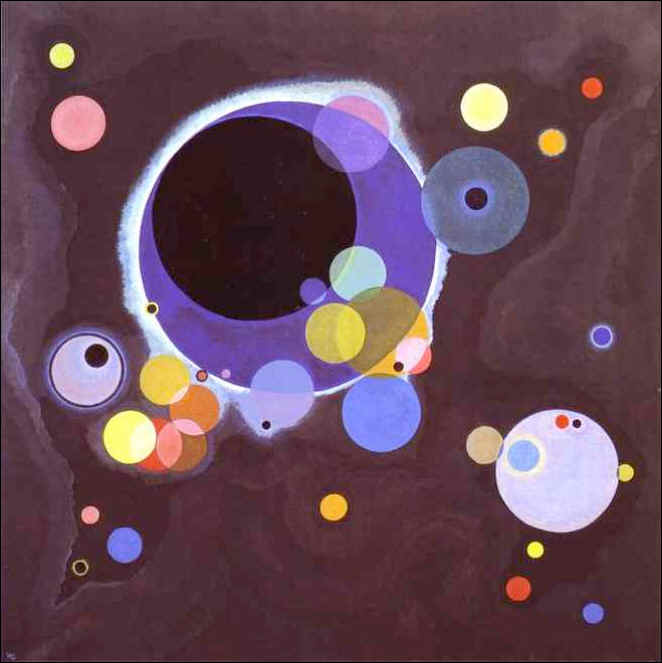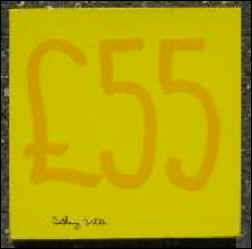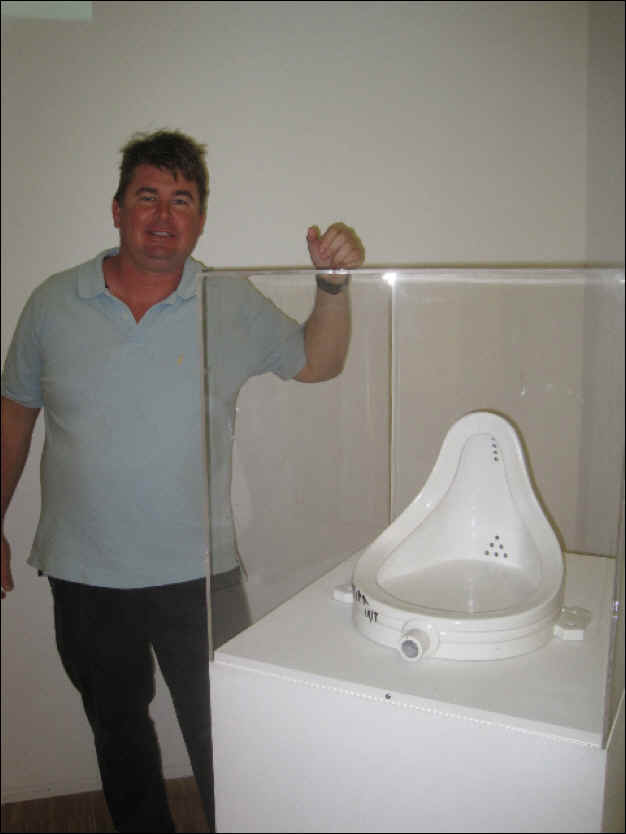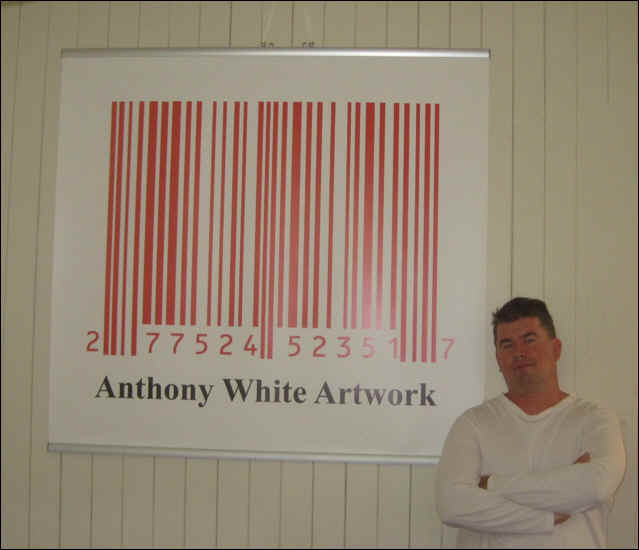
Anthony White's Guide to Conceptual Art
History
Since the invention of the modern camera I really donít see any need for someone to be doing traditional landscapes or portraiture. Whatís the point of spending hours painting something that a camera will capture a lot better and cheaper in a matter of seconds?
In the past painting landscapes and portraits was an important way to record history. The people who excelled at it should probably be known as craftsmen rather than artists, as the craft was, really just copying what was in front of them. An artist would have added something.
I believe that modern art started when the camera was invented. As cameras became cheaper and more accessible artwork became more interesting and varied.
Conceptual art came out of this modern art movement. Basically the concept is more important than the artwork. You donít need to be able to paint a good still life, you just need a good idea.
Good art should make you think. It can also make you happy, laugh, angry, sad or something else, basically provoke a reaction. Get your brain going. When I see a picture of a Gum Tree I usually yawn and start getting sleepy.
However really, really good art inspires you to reach for your wallet.
What
is the difference between abstract and conceptual art?
Terrible question, but I feel I must answer it because so many people call artwork abstract when it clearly isnít.
This
is an example of abstract work.

I have no idea about what the artist was on about but I am sure it
will look good on your wall and because it is a Kandinsky
you will have a good story to tell your friends about the artist they wanted to
put in the loony bin. The painting is also worth millions of dollars so that
might also impress someone.

This is the 55 Pound Painting. Nothing too hard to understand about the title. Have a look at the painting. You see a pound sign and two fives. Nothing abstract about that. Notice the pound sign looks like a pound sign and the fives look like fives. This work is clearly not abstract.
(It is also considered to be one of the
top 50 favourites on Saatchi Online www.saatchi-
Famous
artists that did not produce art.
ďThatís not art.Ē I get an inner glow when anyone ever describes my work that way. Art history books are filled with people who were told that they are not producing art such as Picasso, Miro, Warhol, Kandinski, Pollock and even Monet. These guys were just way too radical. The stuff that never used to be art some how managed to become best art of their era.
Often with conceptual art the skill is not in the doing the art but rather the selling of the art. If you see some art that looks really easy to do in a public art gallery donít panic. Chances are your taxes paid for it!
I would say that success with conceptual art and art in general is 90% marketing and 10% production. My own artwork is definitely a victory of marketing over substance.
I often feel that in order to be a famous artist you need two groups of people. One group that really love your work and another group that really hate your work., this way the two groups end up having a discussion and interacting with each other. This generates publicity. If it results in a stabbing or shooting even better. I do prefer people who love my work. They are the ones who buy it. The ones who really hate my work tend to do a good job advertising it.
Maybe the famous artists donít even produce art. They just produce good stories.
Itís not art unless you read about it in the papers.
My
History
What got me into art?
The artists I was first interested in I donít think it was their artwork that impressed me as much as their lifestyle. If anything their lives seemed to be fun. Even the ones who committed suicide still looked like they had a good life.
Have you ever heard of anyone getting into law, accounting or dentistry just for the lifestyle?
The first commercial art exhibit I remember seeing was at Phillip Bacon Galleries in Brisbane, the artist on show was Jeffery Smart. I went because a couple of friends recommended it and I was not disappointed. The work was brilliant and didnít need clever marketing to sell it. What I also noticed were the red dots added up to over one million dollars (1993 when a million was worth something). I was there the day after opening night. Knowing a bit more now I have a feeling the gallery puts on two opening nights. The first is for the people who will actually buy the work and the second is more like a social gathering for a media photo.
My mind was thinking about the large profit margins and mark up you can get on artwork. What a fantastic business.
I often tell people I first became interested in art when I started dating girls and i used to take them to art galleries where it would not cost me anything but this is not true. I was always intrigued with the potentially high mark up on art.
My
first experience with modern/conceptual art.
I was in high school and I wandered in to the Institute of Modern Art in Brisbane. On the top floor was a classic three-man tent pitched in the middle of the room and nothing else except a book to leave your comments. Comment were left like
What a waste of taxpayer money.
Brilliant!!!
This sucks.
Only a genius could portray the facts of life so simply.
Etc etc
I knew then that this was the sort of art I loved. Art that made you think. For me the best part of this art was reading the comments book. This book could be placed in a room with any modern art peace and people would still make the same comments.
Today when I go to a modern art gallery
it is still much the same. I find what people have to say about the art more
interesting than the actual art itself. Looking at modern art can create many
conversation openers with the people around you.
A
mockery of art
I often hear this from artists who donít sell much artwork when they are describing The Money Series. It really isnít my fault that some people paint for financial gain and not just visual beauty. What is someone trying to tell the world when they produce a painting of a boat on the lake?
For the purist out there I hate to tell you that the art industry revolves around money and not visual beauty. Paint costs money, canvas costs money, art invitations cost money, wine at the openings cost money. Who pays for this?
Joining
MOMA etc
When I lived in a capital city I was on the mailing list for quite a few galleries. What could be better than free wine & cheese while looking at artwork. Hone in on the galleries that are generous with the wine. But be careful. I have a friend who is an artist and has a policy of trying to get his guests drunk at his openings. He sells more art that way.
I find the best value for money comes from being a member of government funded galleries. Usually this is inexpensive, the opening nights tend to be better catered and you arenít pressured to buy anything because usually nothing is for sale. They want a lot of people to turn up on opening nights so they can take some photos that will ensure they receive more funding for next year and keep their cushy overpaid jobs.
Art
Tourism
What I find really amazing is art tourism. It really is alive and out there. By the time politicians acknowledge this movement it will all be over. People really do travel around the world to see specific art and specific art galleries. I know I have.
If you want to create an instant tourist attraction for your town that will bring in rich and intelligent people from all around the world then just donate at least 100 Anthony White paintings to your local gallery. Either that of buy some Van Goghís and Monetís.
How
to Understand Conceptual Art
Typically men will never understand conceptual art. We are just too logical for it.
The fact that most conceptual art does not make a lot of sense is probably the reason why women understand it.
Some
tips in making conceptual art
Repetition Ė Have hundreds of items that are all the same until it fills the room. Equal spacing between the items may be important.
Enlarge Ė take something that is normally small and then enlarge it to ridiculous proportions.
Shrink Ė take something that is normally large and reduce it to a ridiculously small size.
Donít do anything. Just take an item off the shelf in KĖMart and put it in an empty white room.
Take something that is normally not considered art and just call it art. (A urinal maybe)

Keep your costs down
- donít rule out using something you already have at home.
- Industrial waste is often cheap, boring and repetitive which can make for great art.

Just in case people donít know that I am making art I make it clear by writing ďartworkĒ on what I am selling.
I
can do that
Often the skill is not in doing the work. The real skill is getting the work displayed at the Tate Gallery.
---
BETA
This is the BETA version so feel free to write in and let me know what you think.